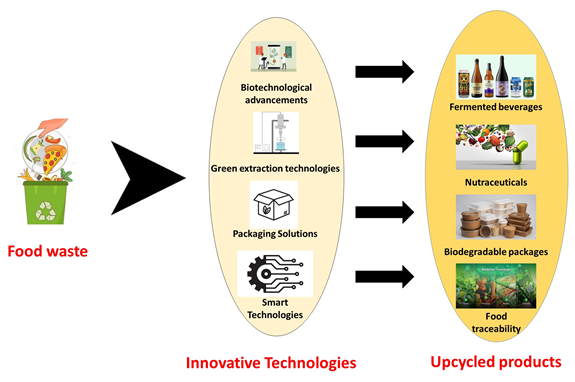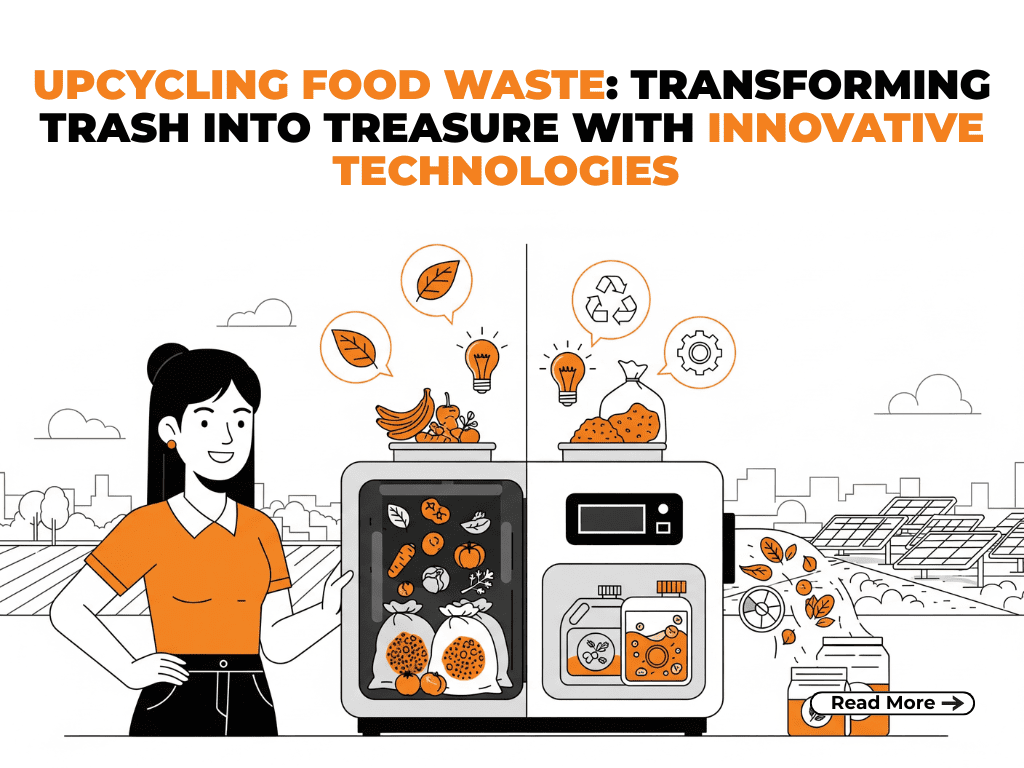As world GDP keeps rising, it brings with it an unfortunate side effect: the mounting creation of waste—more importantly, food waste, which now casts a critical shadow with profound economic, environmental, and social implications. Modern industrial and sustainable food systems built to support an expanding population—now over 8 billion and projected to come close to 9 billion by 2050—are stretching critical resources such as land, water, and energy. To satisfy growing demand, food production worldwide needs to grow by an estimated 70% by 2050. In keeping with this vision, intensive farming and processing methods have become standard. Yet whereas these systems can help ensure food security, they also produce tremendous amounts of waste—an estimated 150 billion metric tons worldwide, at a staggering annual rate of 7.5%. Policy frameworks must increasingly prioritize sustainability on food to align consumption with planetary boundaries. As per the Food and Agriculture Organization (FAO), almost one-third of the total food produced for human consumption, equating to roughly 1.3 billion tonnes annually, is lost or wasted. This waste accounts for a major chunk of biodiversity loss, releases powerful greenhouse gases, and speeds up climate change. In fact, if wasted food were a nation, it would be the world’s third-largest producer of greenhouse gases, only after China and the U.S.
But this is not simply an environmental concern—it’s a contradiction of the globe. While almost 800 million go hungry, nearly 40% of food produced globally goes to waste. This would feed more than 3 billion people, with regional food excesses alone sufficient to feed hundreds of millions in Asia, Europe, Latin America, and Africa. Strengthening sustainable food systems is essential to ensure long-term resilience in global supply chains. To put it in context, the amount of food lost worldwide could fill a nation the size of India and Canada combined. Thus, we require sustainable and scalable solutions that depart from traditional waste management. This is where the theory of valorization comes in—the art of converting waste and discarded materials into usable assets. With the circular economy in view, and boosted by state-of-the-art technologies, food waste is no longer a sure loss but a missed opportunity. Emerging technologies are reshaping sustainability and food production, helping reduce environmental footprints across industries. By moving away from linear “take-make-dispose” systems to regenerative ones that upcycle food waste to create high-value products, we can avoid environmental degradation, capture lost resources, and unlock new opportunities for economic growth. This is not simply about waste reduction—it’s about reframing value, reimagining sustainability, and rethinking the future of food.
Why It Matters- The Real Impact of Wasted Food:
Demand for upcycled food is rising as consumers seek products that reflect values of innovation and ecological balance.
Environmental Impact: Wasted food is a significant greenhouse gas emitter. If food waste were a nation, it would be the third-largest emitter in the world after the US and China. Further, food waste occupies land, water, and energy that are not recovered when the food is wasted. Integrating agroecology and sustainable food systems creates harmony between agricultural practices and nature’s limits.
Resource Degradation: Huge amounts are needed to grow food — fertilizers, fuel, labor, and water. When food is lost, these resources are wasted. For example, roughly 25% of the global freshwater supply goes to producing food that never ends up on a plate.
Economic Cost: Food waste is worth more than $940 billion worldwide each year. Production, shipping, storage, and waste — all lost costs when food is wasted.
Food Security and Ethicality: There are nearly 800 million hungry people in the world, but enormous amounts of healthy food get discarded. Minimizing food waste is a key to ending world hunger and ensuring food equity.
Loss of Biodiversity and Pollution: Overproduction to offset losses causes deforestation, destruction of habitats, and loss of biodiversity. Furthermore, rotting food in landfill dumps methane, a powerful greenhouse gas responsible for global warming.
The upcycling process
Upcycling of food waste is the innovative conversion of food by-products, excess, or leftovers into high-value, safe, and functional products that provide new purpose and utility. In contrast to conventional recycling—usually reducing material to its basic elements—upcycling maintains or increases the value of the original material by innovative repurposing. Innovative digesters generate biogas from food waste, turning discarded meals into renewable energy sources. For example, used coffee grounds are turned into body scrubs or biofuels, whereas fruit peels are utilized to create animal feed, pectin, or natural flavoring. In the same way, cheese whey is now upcycled into protein supplements and vegetable scraps are turned into nutrient-dense snack powders or biodegradable packaging materials. These practices not only minimize environmental impacts but also support a circular economy by releasing trapped value in what was previously regarded as waste. Upcycling is a win-win solution. By minimizing food loss, it saves valuable natural resources such as water, land, and energy. Added to that, it encourages innovation, enabling companies to produce distinctive, sustainable goods while complying with increasing consumer calls for green practices. In an ever-more environmentally conscious world, upcycling has the power to change the way we perceive food waste.

How Innovative technologies is Leading the Charge
Upcycling of food waste has become a viable solution to develop a circular bioeconomy, thanks to the integration of innovative technologies that unlock value in previously unused resources. These technologies enable surplus, by-products, or waste food to be transformed into functional ingredients, materials, and commercial products. The critical technological drivers allowing this shift belong to four broad categories:
Biotechnological advancements: Biotechnological advancements form the cornerstone of food waste upcycling by taking advantage of the metabolic potential of enzymes and microorganisms. Fermentation, for example, is employed to transform carbohydrate waste into bioactive products such as probiotics, organic acids, and fermented drinks. Enzymatic hydrolysis is another prime technique, especially efficient in the breakdown of protein-rich by-products such as okara or fish waste into bioactive peptides and amino acids fit for nutraceuticals. In addition, microbial cultures, such as bacteria and fungi, are employed to manufacture enzymes, single-cell proteins, organic pigments, and other high-value biomolecules from low-cost waste-based substrates. Such biotechnological processes provide environmentally friendly substitutes to chemical technologies and reduce environmental footprint.
Green extraction technologies: These have been developed to utilize food wastes to recycle valuable compounds based on principles of environmental sustainability. Ultrasound-assisted extraction (UAE), Supercritical fluid extraction (SFE), Microwave-assisted extraction (MAE) and Pressured liquid extraction (PLE) are among the green technologies applied for value compound recovery from food waste. UAE involves the use of sound waves to crack cell walls and facilitate the release of antioxidants, polyphenols, and essential oils from plant residues such as fruit skins and seeds. SFE, especially with CO₂, is extensively used for recovery of non-polar molecules like lycopene, caffeine, and omega-3 fatty acids using non-harmful solvents. MAE and PLE are also high-efficiency recovery processes using lower amounts of solvent and shorter processing times and can be used for recovery of functional constituents from agro-industrial residues.
Biopolymer and Packaging Solutions: Advances in biopolymer and packaging solutions provide a sustainable solution to food waste and plastic pollution. Bioplastic packaging products made from fruit skins, tomato peels, and potato starch are being engineered to substitute petroleum-based plastics. Likewise, starch, cellulose, and chitosan derived from agro-waste or shellfish by-products are utilized to produce flexible films with good mechanical and antimicrobial behavior. Food coatings made from upcycled materials such as citrus waste or dairy proteins act as natural barriers that lengthen the shelf life of fresh fruits and vegetables without adding a new packaging waste stream. Such materials are an intersection of waste valorization and sustainable design.
Digital and Smart Technologies: The application of digital and smart technologies is transforming the way food waste is handled and upcycled. Artificial Intelligence (AI) and machine learning are used to monitor, forecast, and avoid food waste throughout the supply chain through consumption patterns analysis, spoilage, and overproduction. Blockchain technology increases transparency and traceability so consumers and producers can ensure the origin and transformation of upcycled ingredients, particularly significant in functional food and cosmetics industries. Intelligent supply chain networks with IoT devices assist in tracking storage conditions and logistics optimization to ensure timely diversion of excess food to upcycling rather than landfilling.
Challenges and considerations
While food waste upcycling has tremendous potential, it is not without challenges. As businesses and entrepreneurs enter this new territory, they need to be aware of a set of issues that might affect the scalability and success of their efforts.
Regulatory Uncertainty: Upcycled food is a fairly new product category, and the regulatory environment surrounding it is still underdeveloped. Regulations for labeling, food safety, and certification standards are often inconsistent or lacking. Without well-established frameworks, it can become difficult for companies to certify compliance or gain approval in different markets.
Inconsistent Supply of Raw Materials: Upcycled products are highly reliant on by-products and waste streams, whose quality, quantity, and availability may fluctuate based on seasonality, production fluctuations, or supply chain interruptions. This unpredictability can create severe challenges for sustaining product consistency and fulfilling production requirements.
Consumer Perception and Acceptance: Although consciousness regarding sustainability is increasing, not everyone is at ease with consuming food produced from “waste.” Hesitation arises due to doubts regarding safety, hygiene, and taste. Hurdling this disbelief needs to be done through open communication, transparency, and building brand trust over a period of time.
Production and Quality Challenges: Converting food waste into wholesome, high-quality products is frequently more complicated than it appears. It can involve sophisticated processing technology, customized infrastructure, and rigorous systems of quality control to provide the ultimate product that is safe and desirable. Such demands raise production costs and process sophistication.
Need for Market Education: Because upcycled food is still a new idea for many, stakeholder and consumer education is critical. Businesses must invest in storytelling, marketing, and outreach programs that reveal the environmental advantages, safety, and nutritional quality of their upcycled products. Not only educating the purchasers but also the retailers, supply chain partners, and internal staff will be critical to sustained growth.
Although upcycling is a key that unlocks sustainability, innovation, and added value, it is not without unique operating and strategic challenges. Its success is subject to having the skills to weather a changing environment—diversity of technical innovation with consumer responsiveness and regulatory alertness.
Final thoughts
With the ecological footprint of our everyday habits more visible than ever before, the need to rethink and redesign our consumption patterns is more pressing than ever. Among the most critical of these is food waste—a vast environmental, economic, and moral burden highlighting the inefficiencies of our world’s food systems. But in this challenge also lies great potential for change. The companies and communities that embrace sustainable food values are setting benchmarks for a conscious future.
Upcycling is not merely a technological solution, but also a transformative change of heart—a way of envisioning possibility in what was previously waste. By embracing the latest innovation such as fermentation, enzymatic bioprocessing, and green extraction methods, we are no longer restricted to a linear approach to production and disposal. These technologies are used to upcycle food waste into nutraceuticals, bio-packaging, natural actives, and shelf-stable powders, creating value at all points of the supply chain. Combined with AI-driven waste tracking, blockchain-provided transparency, and intelligent supply chain systems, not only is the upcycling movement evolving, it is becoming smart and resilient. But technology alone will not drive the future. The companies, brands, and communities that are embracing the spirit of upcycling are leading the way in redefining what it means to be progressive. Upcycled items are more than creative design—they are declarations of responsibility, intention, and vision. They prove that being sustainable is not a marketing catchphrase but an underlying value that creates real, quantifiable change.
Looking forward, the most successful and admired brands won’t be those which merely minimize waste, but those who transform it—those who envision opportunity in the ignored and are determined to create systems where economic profitability, social responsibility, and environmental sustainability converge. The future is for those who know that innovation is driven by purpose, ethics, and impact.














